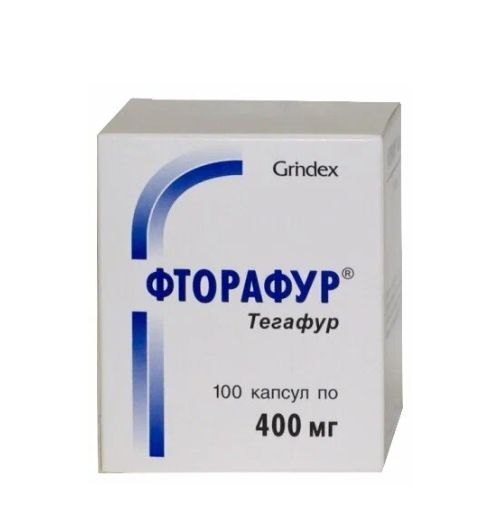Ftorafur 400mg 100 caps.
214,00 €
Antitumor drug
In stock
Save this product for later
Customer reviews
Reviews only from verified customers
No reviews yet. You can buy this product and be the first to leave a review.
Ftorafur 400mg 100 caps.
Product Details
Ftorafur 400mg 100 caps.
Description
The capsules are solid gelatin, with a yellow body and an orange lid; the contents of the capsules are white powder, odorless.
Auxiliary substances: stearic acid - 4 mg.
Capsule body composition: titanium dioxide (E171) - 2%, quinoline yellow dye (E104) - 0.7139%, iron oxide red dye (E172) - 0.0057%, gelatin - up to 100%.
Capsule lid composition: titanium dioxide (E171) - 2.5%, quinoline yellow dye (E104) - 0.1586%, crimson dye (Ponceau 4R) (E124) - 0.1983%, gelatin - up to 100%.
100 pcs. - plastic jars with a capacity of 150 ml (1) - cardboard boxes.
Clinical and pharmacological groups / Group affiliation
Antitumor drug. Antimetabolite
The active ingredient
is tegafur
Pharmacotherapy Group
Antitumor agent, antimetabolite
Storage conditions
The drug should be stored out of the reach of children, protected from light, at a temperature not exceeding 25 ° C.
Expiration date
Shelf life is 4 years. Do not use after the expiration date indicated on the package.
Pharmacological action
The antitumor effect is due to a violation of the synthesis of DNA and RNA. The fluorouracil formed as a result of hydrolysis inhibits the enzyme thymidylate synthetase and DNA synthesis, is introduced into the structure of RNA instead of uracil, making it defective, and inhibits cell proliferation.
In tumor cells, it is converted to 5-fluorodeoxyuridine-5-monophosphate, which is then phosphorylated into triphosphate and incorporated into RNA, and phloxuridine monophosphate, which inhibits thymidylate synthetase. It is less toxic and better tolerated by patients than 5-fluorouracil.
Indications
colon and rectal cancer;
stomach cancer;
breast cancer;
atopic dermatitis;
cutaneous lymphomas.
Method of application, course and dosage
The drug is taken orally. The daily dose of Fluorafur® is 20-30 mg / kg body weight (1.2-1.6 g) in 2-4 doses, but not more than 2 g / day.
The course dose is 30-40 g. The interval between courses is 4 weeks.
The dose of Fluorafur® can be reduced in elderly patients and at a late stage of the disease.
Overdose
Symptoms: increased toxic effects from the gastrointestinal tract, central nervous system and inhibition of hematopoiesis.
Treatment: control of hematopoiesis function for at least 4 weeks, if necessary, symptomatic therapy is performed. The specific antidote to tegafur is unknown.
Drug interaction
Tegafur increases the effectiveness of other chemotherapeutic agents (oxaliplatin, raltitrexide, cyclophosphamide, methotrexate, doxorubicin, mitomycin) and radiation therapy (possibly increasing the risk of adverse events).
The tolerability of tegafur improves with simultaneous administration of calcium folinate.
When used concomitantly with phenytoin, it enhances the effect of the latter.
Inhibitors of microsomal oxidation in the liver increase the toxicity of tegafur.
Use during pregnancy and lactation
The drug is contraindicated for use during pregnancy and lactation (breastfeeding).
Side effect
From the hematopoiesis system: leukopenia, neutropenia, thrombocytopenia, anemia.
From the digestive system: nausea, vomiting, anorexia, abdominal pain, diarrhea, stomatitis, esophagitis, ulceration of the gastrointestinal mucosa, bleeding from the gastrointestinal tract, liver dysfunction, acute hepatitis, acute pancreatitis.
Nervous system disorders: dizziness, confusion, drowsiness, ataxia, euphoria, symptoms of leukoencephalitis.
From the cardiovascular system: cardialgia, angina pectoris, myocardial ischemia, myocardial infarction.
From the side of the organ of vision: diplopia, lacrimation, fibrosis of the tear ducts.
From the skin and subcutaneous tissues: alopecia, impaired regeneration of the skin and nails.
Others: pharyngitis, allergic reactions (including anaphylactic shock), impaired renal function, dehydration, interstitial pneumonia, loss of sense of smell.
Contraindications for use
terminal stage of the disease;
acute profuse bleeding;
severe liver and/or kidney dysfunction;
leukopenia (less than 3000/ml);
neutropenia (less than 1000/ml);
Thrombocytopenia (less than 100,000/ml);
anemia (hemoglobin level less than 65 g/l);
peptic ulcer of the stomach and duodenum;
infectious diseases;
the risk of bleeding in the gastrointestinal tract;
pregnancy;
lactation (breastfeeding);
age under 18 years (efficacy and safety have not been proven);
hypersensitivity to the components of the drug.
The drug is used with caution in patients with impaired hematopoiesis, impaired liver and kidney function of mild to moderate degree, as well as impaired glucose metabolism.
Special instructions
The blood count and the functional state of the liver and kidneys should be monitored regularly.
With prolonged use of the drug, its side effect increases.
It should be borne in mind that the drug inhibits the reproductive function of the patient.
Dizziness, nausea, and vomiting decrease when the daily dose is divided into several doses.
If serious adverse events develop, the drug should be discontinued.
The drug is immediately discontinued if at least one of the following symptoms appears: stomatitis, pharyngitis, esophagitis, bleeding, leukopenia (less than 3000 / ml), neutropenia (less than 1000 / ml), thrombocytopenia (less than 100,000 / ml). The effect on hematopoiesis may occur 8-14 days after the end of treatment.
During treatment, careful oral care is necessary.
Use in pediatrics
The safety of the drug in children has not been studied.
Influence on the ability to drive vehicles and mechanisms
The adverse effects of the drug Fluorafur® on the ability to drive a car and work with mechanisms have not been reported. However, if side effects such as dizziness and drowsiness occur during the use of the drug, you should not drive a car or perform work that requires special attention and quick reactions.
Use in cases of impaired renal function
It is contraindicated in severe renal impairment.
The drug is used with caution in patients with mild to moderate renal impairment.
Use in cases of liver dysfunction
It is contraindicated in severe liver dysfunction.
The drug is used with caution in patients with mild to moderate hepatic impairment.
Terms of implementation
The drug is available by prescription.
The owner of the registration certificate
GRINDEX AO (Latvia)
Ask a question or inquire about delivery to your country
Display prices in:EUR
